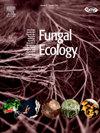牢不可破:燕窝真菌能忍受极端的非生物压力
IF 2.2
3区 环境科学与生态学
Q3 ECOLOGY
引用次数: 0
摘要
虽然许多文献关注植物和原核生物对非生物胁迫的耐受性,但真菌的环境抗性仍未得到充分研究。许多真菌具有帮助它们忍受极端环境扰动的特性。燕窝真菌产生由担子孢子、担子、菌丝和黑化壁组成的“圆孔菌”,但它们对环境压力的耐受性目前尚不清楚。我们将三种远亲燕窝真菌(Cyathus poepigii, crucbulum parvulum, Nidularia pulvinata)的巢周暴露在极高温、极低温和长时间紫外线(UV-C)辐射下。在高温处理后,燕窝真菌的生存能力下降,但三种真菌在40℃左右的高温下均表现出耐受性。相比之下,周透岩不受冷冻或直接紫外线照射的影响。虽然燕窝真菌通常不会在极端条件下发现,但三种远亲物种在暴露于极端环境6或24小时后发芽良好。需要更多的研究来澄清是否其他产生环二醇的真菌也具有这种对恶劣环境条件的广泛耐受性。本文章由计算机程序翻译,如有差异,请以英文原文为准。
Unbreakable: Bird's nest fungi tolerate extreme abiotic stresses
While much of the literature focuses on plant and prokaryote tolerance towards abiotic stresses, environmental resistance by fungi remains understudied. Many fungi have traits that help them to tolerate extreme environmental perturbations. Bird's nest fungi produce ‘peridioles’ which consist of basidiospores, basidia, hyphae, and melanized walls, but their tolerance towards environmental stresses is currently unknown. We exposed the peridioles of three distantly related bird's nest fungi species (Cyathus poepigii, Crucibulum parvulum, and Nidularia pulvinata) to extremely high temperatures, extremely low temperatures, and prolonged ultraviolet (UV-C) radiation. The viability of bird's nest fungi peridioles declined after high heat treatments although all three species showed tolerance up to about 40 °C. In contrast, peridioles were unaffected by freezing or direct ultraviolet radiation. Although bird's nest fungi are not typically found under extreme conditions, three distantly related species germinated well following exposure to extreme environments for either 6 or 24 h. More research is needed to clarify whether other peridiole-producing fungi share this wide tolerance of harsh environmental conditions.
求助全文
通过发布文献求助,成功后即可免费获取论文全文。
去求助
来源期刊

Fungal Ecology
环境科学-生态学
CiteScore
5.80
自引率
3.40%
发文量
51
审稿时长
3 months
期刊介绍:
Fungal Ecology publishes investigations into all aspects of fungal ecology, including the following (not exclusive): population dynamics; adaptation; evolution; role in ecosystem functioning, nutrient cycling, decomposition, carbon allocation; ecophysiology; intra- and inter-specific mycelial interactions, fungus-plant (pathogens, mycorrhizas, lichens, endophytes), fungus-invertebrate and fungus-microbe interaction; genomics and (evolutionary) genetics; conservation and biodiversity; remote sensing; bioremediation and biodegradation; quantitative and computational aspects - modelling, indicators, complexity, informatics. The usual prerequisites for publication will be originality, clarity, and significance as relevant to a better understanding of the ecology of fungi.
 求助内容:
求助内容: 应助结果提醒方式:
应助结果提醒方式:


